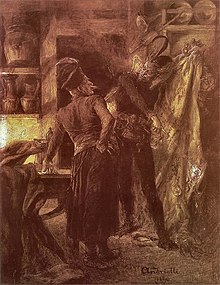Pan Twardowski

Pan Twardowski (
The tale of Twardowski exists in various versions, and forms the basis for many works of fiction, including the humorous ballad "Pani Twardowska" by Adam Mickiewicz.[2] The folklore is commonly assumed to have been heavily inspired by the similar German story of Faust, with which there are many parallels.
Legend
According to an old legend, Twardowski was a nobleman (
With the devil's aid, Twardowski quickly rose to wealth and fame, eventually becoming a courtier of King
After years of evading his fate, Twardowski was eventually tricked by the devil and caught not in the city, but at an
Historical Twardowski
Dr. Jan Kuchta in his 1935 doctoral thesis "Cracovian Warlock of XVI Century. Master Twardowski" suggested that Twardowski may have been a
"Pan" – used in modern
Twardowski's given name is sometimes given as Jan (John), though most versions of the tale do not mention a given name. Pan Twardowski may have been confused with the Polish
Twardowski in literature, music, film and gaming

The legend of Pan Twardowski has inspired a great many Polish, Czech, Ukrainian, Russian, and German poets, novelists, composers, directors, and other artists.
One of the best known literary works featuring Pan Twardowski is the humorous ballad Pani Twardowska by Adam Mickiewicz (1822). In this version of the story, Twardowski agrees to be taken to Hell on condition that the Devil spends a year living with his wife, Pani Twardowska. The Devil, however, prefers to run away and thus Pan Twardowski is saved. In 1869 Stanisław Moniuszko wrote music for the ballad.
Other works based on the legend include:
- Pan Tvardovsky, an opera by Alexey Verstovsky, libretto by Mikhail Zagoskin (1828);
- Pan Tvardovsky, Zagoskin's short story from the collection An Evening on the Khopyor (1834);
- Mistrz Twardowski [Master Twardowski], a novel by Józef Ignacy Kraszewski (1840);
- Tvardovsky, a ballad by Semen Hulak-Artemovsky;
- Pan Twardowski, a ballet by Adolf Gustaw Sonnenfeld (1874);
- Pan Tvardovski, an opera by Ivan Zajc (1880);
- Twardowski, a poem by Jaroslav Vrchlický(1885);
- Mistrz Twardowski, a poem by Leopold Staff(1902);
- Pan Twardowski, a ballad by Lucjan Rydel (1906);
- Pan Tvardovsky, a film by Ladislas Starevich (1917);
- Pan Twardowski, a ballet by Ludomir Różycki (1921);
- Pan Twardowski, a film by Wiktor Biegański (1921);
- Pan Twardowski, czarnoksiężnik polski [Pan Twardowski, a Polish sorcerer], a novel by Wacław Sieroszewski (1930);
- Pan Twardowski, a film by Henryk Szaro, screenplay by Wacław Gąsiorowski (1936);
- Pan Twardowski oder Der Polnische Faust [Pan Twardowski or The Polish Faust], a novel by Matthias Werner Kruse (1981);
- Dzieje Mistrza Twardowskiego (The Story of Master Twardowski), a film by Krzysztof Gradowski (1995).
- Twardowsky, a short sci-fi film from Polish Legends series directed by Tomasz Bagiński (2015)[4]
- Hearts of Stone, an expansion to RPG game The Witcher 3: Wild Hunt (2015), has a main storyline heavily inspired by the legend.
Pan Twardowski is also a popular character in the
Places associated with Pan Twardowski


Pan Twardowski is said to have lived in or near
(now part of Kraków).Across Poland, there are a number of inns and pubs called Rzym ("Rome"), all of which claim to be the one where Pan Twardowski met the devil. The oldest of these inns date back to only the late 17th century, about 100 years after Twardowski's time. The one in Sucha is probably the best known of these inns.
In the
It is also said that Pan Twardowski spent some time in the city of Bydgoszcz, where, in his memory, a figure was recently mounted in a window of a tenement, overseeing the Old Town. At 1:13 p.m. and 9:13 p.m. the window opens and Pan Twardowski appears, to the accompaniment of weird music and devilish laughter. He takes a bow, waves his hand, and then disappears. This little show gathers crowds of amused spectators.
See also
References
- ^ a b c d e f Hanna Widacka. "Legendy i fakty o Mistrzu Twardowskim". www.wilanow-palac.pl (in Polish). Retrieved 2023-02-14.
- ^ Adam Mickiewicz. "Pani Twardowska". mickiewicz.kulturalna.com (in Polish). Retrieved 2009-03-20.
- ^ a b c Roman Bugaj. "Mistrz Twardowski". www.wilanow-palac.art.pl (in Polish). "Mówią wieki", nr 9, 1972. Archived from the original on 27 October 2007. Retrieved 2009-03-20.
- ^ Tomasz Bagiński, 2015 - Full movie on YouTube streaming service
- ^ a b Jan Mielniczka (2007-10-29). "Legendy o Węgrowie". www.wegrow.com.pl (in Polish). Archived from the original on 2008-10-06. Retrieved 2009-03-19.
- ^ Górczyk, Wojciech Jerzy (January 2018). "Jan Dobrogost Krasiński i jego związek z "Lustrem Twardowskiego"". Muzealne Rozmaitości.
Further reading
- JSTOR 23999892.
- Hendrykowska, Małgorzata; Hendrykowski, Marek (2017). "Pierwsza ekranizacja Pana Twardowskiego" [The first film adaptation of Pan Twardowski]. Images. The International Journal of European Film, Performing Arts and Audiovisual Communication (in Polish). 20 (29). Uniwersytet Adama Mickiewicza: 149–160. .
- Schamschula, Walter (2023). "Pan Twardowski: The Polish Variant of the Faust Legend in Slavic Literatures: A Study in Motif History". In Birnbaum, Henrik (ed.). California Slavic Studies. Vol. XIV. Berkeley: University of California Press. pp. 209–231. ISBN 978-0-520-34307-8.
- Zinkow, Leszek (2013). "Mistrz Twardowski wśród egipskich mumii" [Master Twardowski Among Egyptian Mummies]. Przegląd Orientalistyczny (in Polish) (1-2 (245-246)): 3–18.
